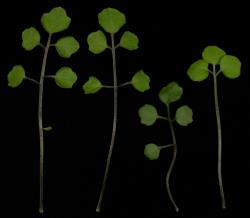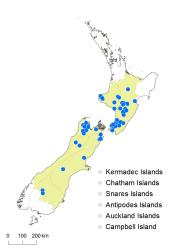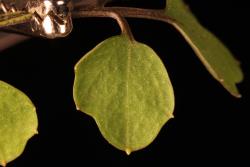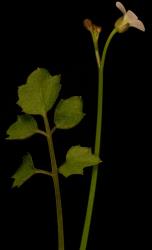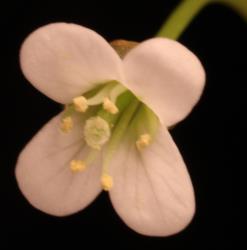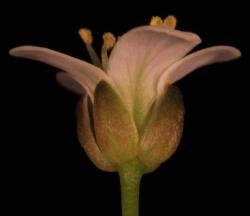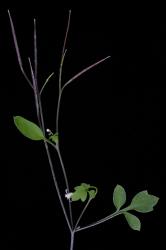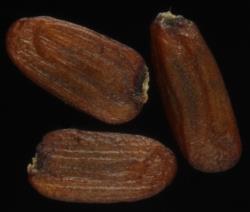- = Cardamine debilis DC., Prodr. [A. P. de Candolle] 2, 265 (1821) nom. illeg.
- ≡ Cardamine hirsuta var. debilis (DC.) Hook.f., Handb. New Zealand Fl. 12 (1864)
Perennial herb, single rosette or with short lateral branches, stem and branches 0.8–1.3 mm diam. Leaves up to 130 mm long, pinnatisect, lamina 15.0–60.0 × 8.0–35.0 mm, green, sometimes purple on abaxial surface, membranous, sparsely to moderately hairy on adaxial surface, glabrous or occasionally sparsely hairy on abaxial surface, margin and petiole; hydathodes prominent on terminal and lateral leaflet margins. Terminal pinna 3.0–33.0 × 3.0–27.0 mm, simple, sometimes with several shallow lobes, broadly reniform, orbicular, orbicular-rhomboid, apex obtuse with a conspicuous hydathode, base obtuse, truncate to cordate; lateral pinnae 2–6, 2.0–20.0 × 2.0–20.0 mm, orbicular, orbicular-rhomboid, to broadly elliptic, base often oblique, petiolule 1.0–8.0 mm long; petiole up to 60 mm long; hairs 0.3–0.5 mm long, recurved. Cauline leaves similar to rosette leaves, but with fewer and narrower leaflets, becoming smaller in all parts; upper leaves 5.0–10.0 × 2.0–3.5 mm, increasingly linear, simple. Inflorescence racemose, sometimes with lateral racemes, each raceme 6–12-flowered; peduncle up to 430 mm long, 0.9–1.4 mm diam. At base, spreading to ascending, glabrous to sparsely hairy. Pedicels 7.0–17.0 mm long, 0.5–0.6 mm diam., glabrous. Sepals 2.1–2.5 × 1.0–1.2 mm, elliptic-oblong to broadly elliptic, saccate, green or red-brown, glabrous or sparsely hairy distally, margin white and membranous, apex obtuse, base truncate. Petals 4.8–7.0 × 2.0–3.0 mm, white, limb narrowly obovate to obovate; apex obtuse; base cuneate, tapering to an indistinct claw or claw up to c. 1.0 mm long. Stamens 6; median filaments 4, 3.4–3.5 mm long; lateral filaments 2, 2.7–3.2 mm long; anthers 0.4–0.7 mm long, cream to pale yellow, when dehiscent held at a similar height to or slightly below the stigma. Ovary 4.3–4.5 mm long, 0.5–0.6 mm diam., ± terete, green, glabrous; ovules 8–14; style 0.6–1.0 mm long, ± terete; stigma 0.5–0.6 mm diam. Siliques 25.0–44.0 × 1.0–1.2 mm, glabrous, style (1.8–)2.5–8.5 mm long; valves green to red-brown at maturity, straw-coloured when dehiscent; replum 0.3–0.4 mm wide. Seeds 1.1–1.8 mm long, 0.9–1.2 mm wide, 0.3–0.4 mm thick, oblong, green-brown; wing absent.
Cardamine dolichostyla is distinguished from C. chlorina by its narrower sepals, longer filaments, fewer ovules, longer and narrower siliques with a prominent style, and henna seeds.
North Island: Volcanic Plateau, Taranaki, Southern North Island.
South Island: Western Nelson, Sounds Nelson, Westland, Marlborough, Canterbury, Otago.
Cardamine dolichostyla is widespread in North and South Islands.
Cardamine dolichostyla occurs in damp and moist situations in forest and on forest margins, and in open areas such as track margins and river flats and terraces.
Cardamine dolichostyla is assessed as having a conservation status of Not Threatened (de Lange et al. 2018).
Flowering August–March; Fruiting August–April.
Some plants from the Whanganui−Mt Taranaki area have leaves with a conspicuous purple-violet abaxial surface (e.g., Mt Taranaki, CHR 189238; Jerusalem, CHR 286937).



